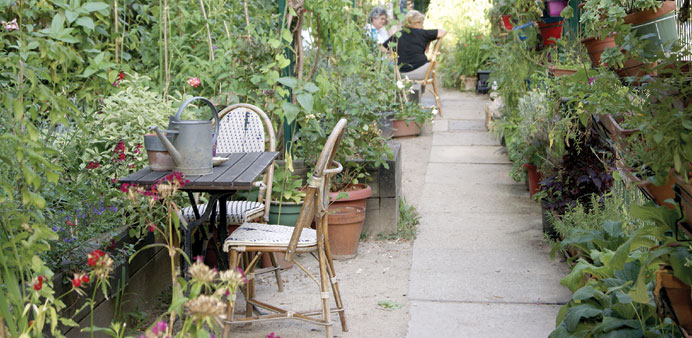In the Jardins du Ruisseau, a long, thin common-ground garden in Paris, two visitors (background) sit and admire the green.
By Verena Hoelzl
Anne-Marie’s garden is 200m long and just 4m wide. It’s not hers alone: she shares it with almost 500 other Paris residents. It is joint plots like this that help Paris urbanites resist the stress of urban living.
This one in the Clignancourt district, in the northern part of Paris, is not far from the city’s freeway ring. Anne Marie, a pensioner, is here almost every day, tending to tomato vines, sunflowers and lavender plants.
The “Jardins du Ruisseau,” stretched out like a garden hose, is situated in a cutting next to a disused railway track. It is like a broad basin, resembling a canal without any water. Seated on folding chairs in the garden, the view is the walls of apartment buildings rising up into the sky.
This common-ground garden was one of the first of its kind in Paris. “In the past, neighbourhood residents would simply dump their trash here,” notes garden founder Denis Loubaton. “In 2003, Green Party city politicians launched an initiative to make land throughout Paris available for gardening.”
A great deal has happened since then. More than 90 “jardins partagés” — allotment garden areas — evolved all around Paris, each one distinctly different from the others. The smallest one is just 45 sq m, while the largest is 1,500 sq m. These tiny patches of paradise are found on former industrial sites, interior courtyards or atop the roofs of sports complexes.
Quite often, the gardens are visited by kindergardens, elementary schools and workshops for disabled children in order to give the youngsters a feeling for nature. In the beds of flowers, there are slate tablets on which the names of the kids’ groups are written.
The gardens are accessible at any time for planting and harvesting — provided the gardener first joins the club that sponsors the garden project. Membership in the Jardins du Ruisseau costs €15 ($20) annually.
For beginners, instruction in gardening is provided at the Maison du Jardinage training centre. But all is not peace and harmony in the lovingly cultivated Jardin du Ruisseau located in the middle of a low-income part of northern Paris.
“We have had our problems with youths who would rather smoke cannabis here than raise tomatoes,” Anne-Marie says. Nor can one be certain of gathering in the hard-earned harvest.
“Recently I wanted to give a zucchini a few more days in the sun before harvesting it,” she said. “The next day, it was gone.”
Pensioner Anne-Marie is sitting together with two lady friends from the neighbourhood at a decorative garden table. Vine-covered arches divide the garden into cosy segments every few metres.
The sun is shining down on the flowery tablecloth that Anne-Marie has been sewing for the past five years. For nearly twice as long she has been coming regularly to the common garden.
On weekends and Wednesdays the garden’s gates are open to guests. Anne-Marie and her two elderly friends keep a wary eye on the visitors. To them, this is territory and outsiders are intruders.
At the end of this small world, chickens are clucking and bees are buzzing around their hives. The garden club harvests 30 to 100kg of honey each year. “Our bees are the healthiest in all of France, because in the city there are no agricultural poisons,” Anne-Marie says, referring pesticides and herbicides.
That may be an exaggeration.
In the neighbouring Buttes Bergeyre district, evening is setting on the grass, flowers and shrubs of a common garden. The gardening neighbours are sitting around a large table beneath a tree. There’s a champagne bottle to be seen — but also a container of poison against snails and slugs. – DPA

